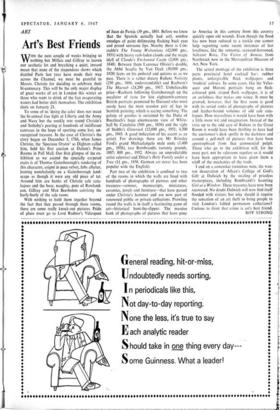Art's Best Friends
ART Wins the next couple of weeks bringing us nothing but Millais and Gillray to leaven our aesthetic lot and breathing a quiet, inward moan that none of the stupendous shows which dazzled Paris last year have made their way across the Channel, we must be grateful to Messrs. Christie for deciding to celebrate their bi-centenary. This will be the only major display of great works of art in London this winter so those who want to drink of the fast evaporating waters had better shift themselves. The exhibition shuts on January 21.
To some of us 'doing the sales' does not mean the bi-annual free fight at Liberty and the Army and Navy but the weekly trot round Christie's and Sotheby's peering at hundreds of indifferent canvases in the hope of spotting some lost, un- recognised treasure. In the case of Christie's the story began on December 5, 1766, when James Christie, the 'Specious Orator' as Dighton called him, held his first auction at Dalton's Print Rooms in Pall Mall. Our first glimpse of the ex- hibition as we ascend the specially carpeted stairs is of Thomas Gainsborough's rendering of this character, soigne in puce velvet, fobs aflutter, leaning nonchalantly on a Gainsborough land- scape as though it were any old piece of tat. Around him are banks of Christie sale cata- logues and the busy, naughty, pens of Rowland- son, Gillray and Max Beerbohm satirising the hurly-burly of the sale room.
With nothing to hold them together beyond the fact that they passed through these rooms, there are some really knock-out pictures. Pride of place must go to Lord Radnor's Velasquez of Juan de Pareja (39 gns., 1801. Before we knew that the Spanish actually had art), sombre smudges of paint delineating flashing back eyes and proud sensuous lips. Nearby there is Con- stable's The Young Waltonians (42,000 gns., 1951) with heavy rain-laden clouds and the magic idyll of Claude's Enchanted Castle (2,000 gns., 1848). Between them Laurence Olivier's double, the Abbe Scaglia by Van Dyck (30,000 gns., 1928) leans on his pedestal and quizzes us as we pass. There is a rather dreary Rubens Nativity (250 gns., 1886, understandably) and Raeburn's The Macnah (24,200 gns., 1917. Unbelievable price—Raeburn following Gainsborough up the escalator of taste for late eighteenth-century British portraits promoted by Duveen) who must surely have the most wooden pair of legs in Scottish painting, which is saying something. The galaxy of goodies is sustained by the Duke of Buccleuch's huge cinemascope view of White- hall by Canaletto (560 gns., 1836) and the sight of Stubbs's Gimcrack (12,000 gns., 1951; 4,200 gns., 1943. A good indication of his ascent as an artist). For drawings there are Mr Brinsley Ford's grand Michaelangelo male nude (3,400 gns., 1936), two Rembrandts (seventy pounds, 1887; 800 gns., 1952. Always an unpredictable artist salewise) and Dfirer's Holy Family under a Tree (1+ gns., 1856. German art never has been popular with the English).
Part two of the exhibition is confined to two of the rooms in which the walls are lined with hundreds of photographs of pictures and other treasures—armour, manuscripts, miniatures, ceramics, jewels and furniture—that have passed under Christie's hammer and are now part of renowned public or private collections. Prowling round the walls is in itself a fascinating game of art—historical hunt-the-slipper. The massive bank of photographs of pictures that have gone to America in this century from this country quickly open old wounds. Even though the flood has now been reduced to a trickle one cannot help regretting some recent instances of lost loveliness, like the romantic, seaweed-festooned, Salvator Rosa, The Vision of Aeneas, from Northwick now in the Metropolitan Museum of Art, New York.
The actual montage of the exhibition is three parts provincial hotel cocktail bar: rubber plants, unforgivable flock wallpapers and `modern' colours. In some cases, like the Velas- quez and Moroni portraits hung on flesh- coloured pink striped flock wallpaper, it is of an awfulness that makes one wince. It must be granted, however, that the first room is good with its seried ranks of photographs of pictures and leather-bound volumes of old sale cata- logues. How marvellous it would have been with a little more wit and imagination. Instead of the vista up to the odd acre of Rubens in the Great Room it would have been thrilling to have had the auctioneer's desk spotlit in the darkness and around a pell-mell of pictures that have been apostrophised from that commercial pulpit. Those who go to the exhibition will, for the most part, not be saleroom regulars so it would have been appropriate to have given them a whiff of the mechanics of the trade.
I end on a somewhat tremulous note, the wan- ton desecration of Alleyn's College of God's Gift at Dulwich by the stealing of priceless masterpieces, including Rembrandt's haunting Girl at a Window. These treasures have now been recovered. No doubt Dulwich will now find itself flooded with visitors but why should it require the sensation of an art theft to bring people to visit London's fabled permanent collections? Curious to think that crime is art's best friend.
ROY STRONG






























 Previous page
Previous page